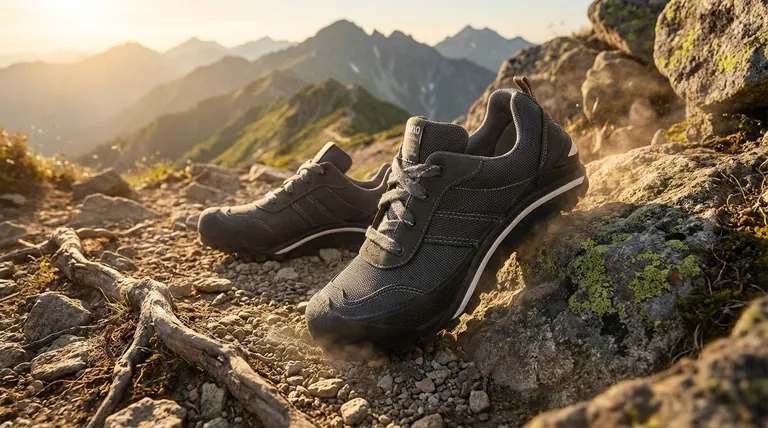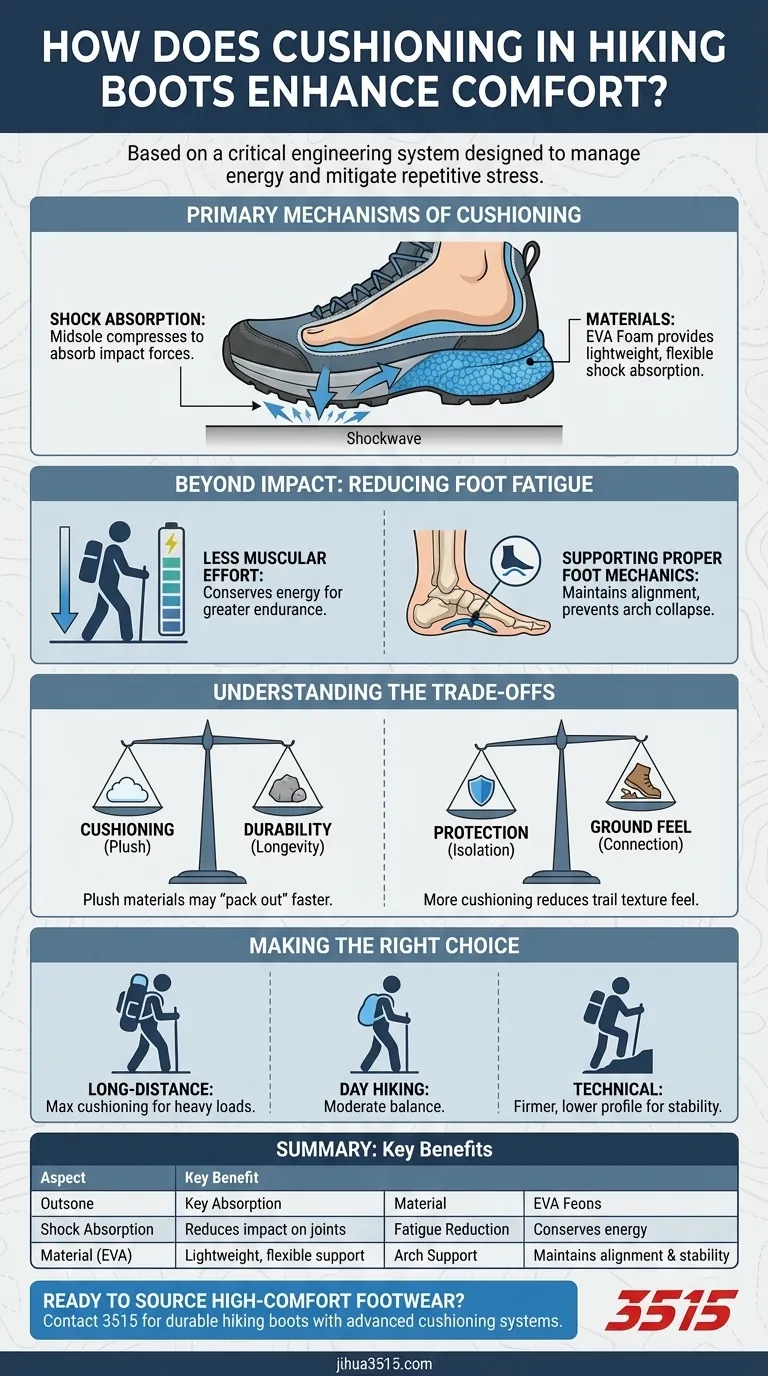At its core, cushioning in hiking boots enhances comfort by absorbing the shock of each step and reducing the cumulative fatigue on your feet and joints. This is primarily achieved through a specially designed midsole, often made of materials like EVA foam, which dissipates impact forces that would otherwise travel up your legs.
The true role of cushioning isn't just to make a boot feel soft; it's a critical engineering system designed to manage energy and mitigate the repetitive stress of hiking, directly translating to less fatigue and greater endurance on the trail.

The Primary Mechanisms of Cushioning
Cushioning is a fundamental component of a boot's chassis, working to protect your body from the relentless impact of walking over uneven terrain.
How Midsoles Absorb Shock
The midsole is the layer between your foot and the hard rubber outsole. It is the primary shock absorber in a hiking boot.
With every step, especially on hard or rocky ground, a significant shockwave travels from the ground into your foot. The midsole material is engineered to compress under this load, absorbing and dampening that force.
This process prevents jarring impacts from reaching your ankles, knees, and hips, which is crucial for preventing soreness and long-term joint strain.
The Critical Role of Materials
The effectiveness of a midsole is determined by its material. Most modern hiking boots use EVA (ethylene-vinyl acetate) foam.
EVA is a lightweight, flexible foam that provides excellent shock absorption. Different densities of EVA can be used to fine-tune the balance between soft cushioning and firm support.
Other materials like foam padding are also used, particularly around the ankle collar and tongue, to prevent chafing and add to the overall sense of comfort.
Beyond Impact: Reducing Foot Fatigue
The benefits of good cushioning extend far beyond simple shock absorption. It plays an active role in keeping you moving efficiently over long distances.
Lessening Muscular Effort
By absorbing impact, the cushioning system reduces the amount of work your muscles and tendons must do to stabilize your body with each footfall.
This conservation of energy is cumulative. Over thousands of steps, it results in significantly less overall foot and leg fatigue at the end of the day.
Supporting Proper Foot Mechanics
Quality cushioning works in tandem with features like arch support to maintain the natural alignment of your foot.
This support prevents your arch from collapsing under load, which is a common cause of foot pain and conditions like plantar fasciitis. A stable foot is an efficient foot.
Understanding the Trade-offs
Cushioning does not exist in a vacuum. It must be balanced with other critical boot characteristics like durability, stability, and fit.
Cushioning vs. Durability
The softest, most plush cushioning materials can sometimes be less durable. Over time and many miles, they can "pack out," or permanently compress, losing their ability to absorb shock effectively.
Conversely, more durable boots often use denser materials, like hard rubber outsoles and leather uppers, which trade some initial plushness for longevity.
Protection vs. "Ground Feel"
A boot with maximum cushioning will isolate you from sharp rocks and roots, providing excellent protection.
However, this comes at the cost of "ground feel"—the ability to feel the texture of the trail beneath your feet. Some hikers prefer less cushioning for a more connected feel, which can aid in balance on technical terrain.
The Necessity of a Proper Fit
Cushioning cannot compensate for a poor fit. A boot that is too loose or too tight will create friction points and inhibit proper foot function, negating any benefits from the midsole.
As the references note, a snug fit ensures the entire support and cushioning system works in harmony with your foot, maximizing both comfort and performance.
Making the Right Choice for Your Goal
The ideal level of cushioning depends entirely on your intended use.
- If your primary focus is long-distance backpacking with a heavy pack: Prioritize boots with maximum cushioning to absorb the added impact from the weight you are carrying.
- If your primary focus is light day hiking on well-maintained trails: A moderate level of cushioning provides an excellent balance of comfort, weight, and ground feel.
- If your primary focus is technical scrambling or off-trail travel: Consider a boot with slightly firmer, lower-profile cushioning to enhance stability and allow for more precise foot placement.
Ultimately, selecting the right cushioning is about matching the boot's engineering to the demands of your adventure.
Summary Table:
| Cushioning Aspect | Key Benefit |
|---|---|
| Shock Absorption | Reduces impact on joints and muscles |
| Material (EVA Foam) | Provides lightweight, flexible support |
| Fatigue Reduction | Conserves energy over long distances |
| Arch Support | Maintains proper foot alignment and stability |
Ready to source high-comfort hiking boots with superior cushioning?
As a large-scale manufacturer, 3515 produces a comprehensive range of durable and comfortable footwear for distributors, brand owners, and bulk clients. Our production capabilities encompass all types of hiking boots and shoes, engineered with advanced cushioning systems to meet the demands of any adventure.
Contact us today to discuss your specific needs and discover how we can enhance your product line with reliable, high-performance footwear.
Visual Guide

Related Products
- Durable Rubber Sole Outdoor Shoes Wholesale & Custom Manufacturing
- Safety Footwear Wholesale Manufacturer for Custom OEM/ODM Production
- Durable Waterproof Rain Boots | Custom Manufacturer for Wholesale & Brands
- Wholesale Safety Footwear Manufacturer for Bulk & Custom OEM Orders
- Wholesale Durable Safety Boots | Custom Steel Toe & Puncture-Resistant Manufacturing
People Also Ask
- Why are vulcanized soles popular in urban fashion? Discover the Legacy of Authentic Street Style
- How do hiking shoes or boots protect feet from environmental hazards? A Guide to Trail-Ready Footwear
- What are the main applications of vulcanized rubber? Unlock Durability for Tires, Footwear & More
- What are some alternatives to hunting boots? Hiking, Rubber & Tactical Boots Explained
- Why are rubber-soled shoes considered multi-weather footwear? Unlock All-Season Traction & Protection



















